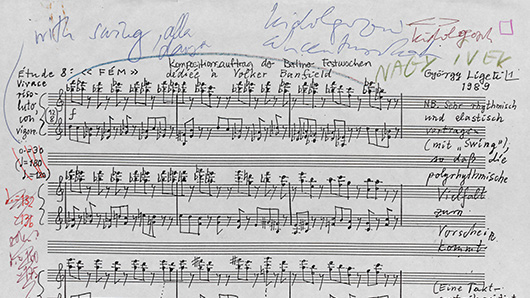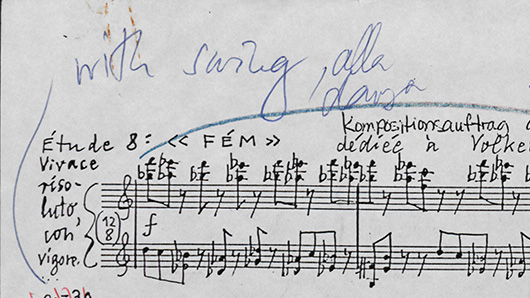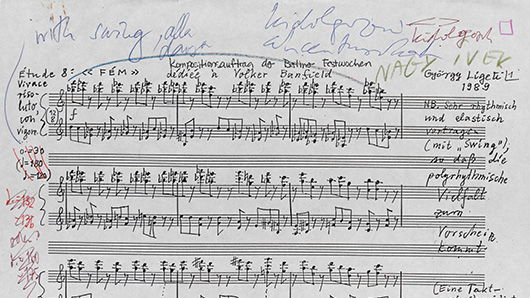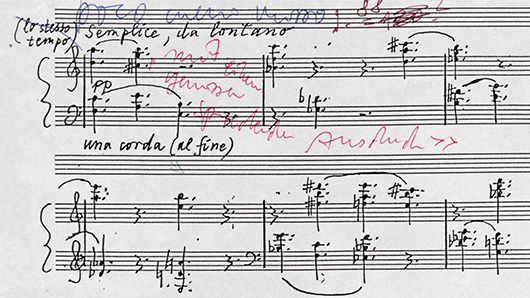



Pierre-Laurent Aimard's performance suggestions are based on his close collaboration with György Ligeti.
The ‘Ligeti’s comments’ function allows you to call up his corrections, additions and explanations in the interactive score, none of which are to be found in the printed score. This critical online edition, compiled by Pierre-Laurent Aimard and Tobias Bleek, takes into account the following sources:
Pierre-Laurent Aimard on Ligetis performance suggestions
Suggestions from and explanations by the composer that Pierre-Laurent Aimard wrote down during their joint working sessions and reviewed for our interactive score. More information on their collaboration and the performance notes can be found in this video as well as in the section ‘Performing Ligeti’.
Revised version of the fair score, which served as a production master for publication and is preserved today in the Paul Sacher Foundation, Basel.

Copy of the autograph fair score of Étude 8: Fém, with annotations by the composer, page 1, Paul Sacher Foundation, Basel.
A copy of the autograph fair score with Ligeti’s annotations, including handwritten corrections and addenda. Notes in German and Hungarian. (György Ligeti Collection, Paul Sacher Foundation, Basel)
“fém = Hungarian for metal”
“like a marionette, light and nervous”
“dancing, light”
“nearly kitsch, but not too much so”
“jazzy”
“not too mechanicaly – try to stay above the musical struggle”
“with a certain elegance”
“a little pointed”
“like a Debussy cakewalk”
“super Schumannesque brilliance”
“Imagine Liszt, with a knowledge of jazz, interpreting Schumann”
“Further references: Bill Evans and Herbie Hancock”
“Accents at the beginning and the end of the phrase (in both hands)”
“Never shorten the end of the phrase (rather play as a dotted quaver/eighth note)”
“(The last pair of quavers/eight notes somewhat tenuto)”
“Avoid the tendency to shorten the last notes, especially in the three-note groups”
“Take care to balance the two hands”
“within the phrases: small crescendi and decrescendi etc.”
“Change dynamics abruptly; like a cut in a film”
“never hesitate or slow down: always with continuity”
Source: Notes by Pierre-Laurent Aimard

Copy of the autograph fair score of Étude 8: Fém, with annotations by the composer, page 1 (detail), Paul Sacher Foundation, Basel.
Phrase mark over the first three beats of the right hand with the Hungarian instruction: “NAGY IVEK” = “big slur” (see image)
Source: Copy of the autograph fair score with annotations by the composer (Paul Sacher Foundation, Basel)

“half-note (minim) = 96, then 90”
Source: Notes by Pierre-Laurent Aimard

Copy of the autograph fair score of Étude 8: Fém, with annotations by the composer, page 1 (detail), Paul Sacher Foundation, Basel.
“half-note (minim) = 96 (after several changes)”
Source: Copy of the autograph fair score with annotations by the composer (Paul Sacher Foundation, Basel)


Copy of the autograph fair score of Étude 8: Fém, with annotations by the composer, page 3 (detail), Paul Sacher Foundation, Basel.
“with a speech like quality”
Source: Copy of the autograph fair score with annotations by the composer (Paul Sacher Foundation, Basel)
“with a speech like quality”
“expressively”
“half dance, half chorale”
“with a Chaplinesque melancholy”
“For performance style listen to Bill Evans’ »On a clear day«”
“With a certain elasticity”
“Never shorten or weaken the last note of each group”
“Dynamik: crescendi und decrescendi”
Source: Notes by Pierre-Laurent Aimard
Ligeti’s interest and admiration for music from Africa
Simha Arom – a renowned music ethnologist and close friend of the composer – speaks about his discussions with Ligeti on African music.


